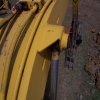Icestationzebra, (what a great moniker!)
I’m from the “if a little is good, and a lot is better, then too much is just about right” school of engineering design. Overbuilding is good. Overbuilding works. Overbuilding keeps Murphy from winning too often!
Perhaps the use of CAE & FEA is ‘improving the breed’ across much of the heavy equipment industry. But as an outsider looking in I’m often left to wonder. My concern is that with much better design tools to use, machinery will be built lighter, which will ultimately have an adverse impact 15 years down the road when the 12th owner learns that the broken CAE & FEA optimized boom is too thin/complex to be safely repaired.
Your right, what I meant to convey was that HUMAN ERROR is the root cause of all material failures. Nothing 'just breaks'.
A robotic welder certainly could work with a transformer based power source. But we (ie. society/etc.) seem so much in the thrall of ‘digital’ that anything ‘old skool’ (like a transformer based welder) seems to be viewed as less than worthless (especially by younger people who know of nothing other than 'digital').
Oh yes, robotic welding systems can produce much more consistently uniform results than most/all human weldors can. Setting aside the issue that adopting these machines has displaced countless jobs (which I find hard to ignore), my issue is that the pulsed inverter based technology employed on thick steel sections consistently produces welds that lack fusion and have more porosity.
Rodney Dangerfield’s catchphrase “I don’t get no respect” seems to fit the job title of weldor all too well. In 2007 the average age of a weldor in America was 54! And it’s not much less than that across the whole of the worlds most developed nations. On the bright side, not many young whippersnappers are trying to oust these rapidly aging weldors out of the workforce! Job security at its finest.
ih100,
I originally contributed to this thread to highlight the ‘whys’ behind at least some of the shortcomings with one of the welding processes (ie. MIG) that was being discussed. However, this can’t really be done without going into at least some of the science and physics behind the root issues at play. Evidently my bad for having the audacity to bring this subject to the attention of forum members.
I believe that all the manufacturers of heavy equipment that are using pulsed inverter based welding systems have embraced a demonstrably inferior technology which is contributing to higher costs and is lowering quality. A perfect loose-loose situation for the customer!
And while I realize that perhaps a narrow line needs to be walked in discussing these issues on this forum, welding is an integral technology of almost every piece of heavy equipment in existence. So if the OEM manufacturers are using a welding process to the detriment of the end users best interests (as pulsed inverter welding is) I believe that forum members deserve to be appraised of the potential downsides resulting.
No, I don’t believe that cutting costs by compromising product quality/durability is a remotely appropriate/defensible business decision.
And while your statement that “the largest manufacturers (certainly in the west) spend billions a year in R&D” is certainly true, you don’t have to look very hard to find publications, web forums, law offices, and courts littered with examples of the consumer being screwed/gypped/hoodwinked by some proportion of this expenditure. I thought about using the term 'Ponzi scheme' to describe this situation, but given that Charles Dickens described just such a scheme long before Charles Ponzi became infamous, perhaps the phrase ‘a dickens of a mess’ is more apt.
I know of NO board level 1st tier OEM heavy engineering executives that are trained/qualified welding engineers. Accountants, yes; lawyers, yes; mechanical engineers, yes; chemical engineers, yes. But welding engineers? I can't find a single one!
And yet ALL these firms make products that extensively rely upon MIG welding for their structural integrity and longevity. Go figure.
I didn’t intend to belittle the capabilities of ‘competent’ weldors anywhere (for there certainly are many all over the globe). However, as an industry, welding soldiers on largely in the technological dark ages, where science and physics seems to be viewed with suspicion (or at least apathy) by a significant percentage of welding practitioners and by those responsible for welding equipment purchasing decisions.
My ‘company’ doesn’t manufacturer anything (much less sell welding equipment). Nobody would employ me!
I’m simply someone who, through spending countless hours (pre-internet) in various reference libraries globally, trying to figure out the scientific reason why the same types of welding defects/material failures were showing up in various industries that I was ‘consulting’ for, I hit upon the idea of looking at what was going on electronically while welding by using an oscilloscope. Wow, what an eye opener!
The use of pulsed inverter welders for thick steel is, as Colonel Sherman Tecumseh Potter on MASH was fond of saying, “Horse Puckey!”
Any oscilloscope can show this to be a factually correct statement.
Best regards,
Steve







